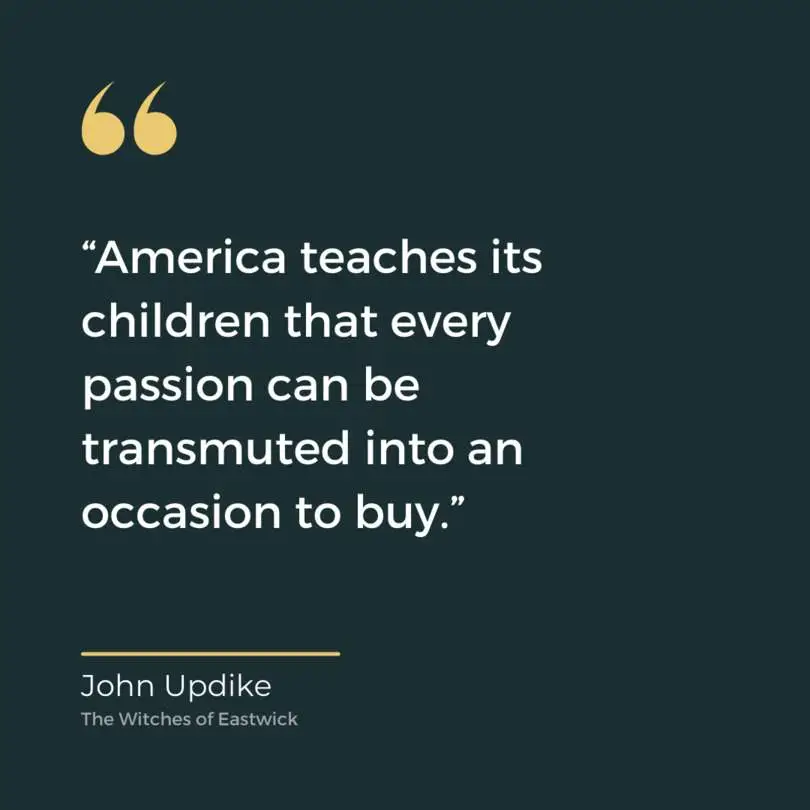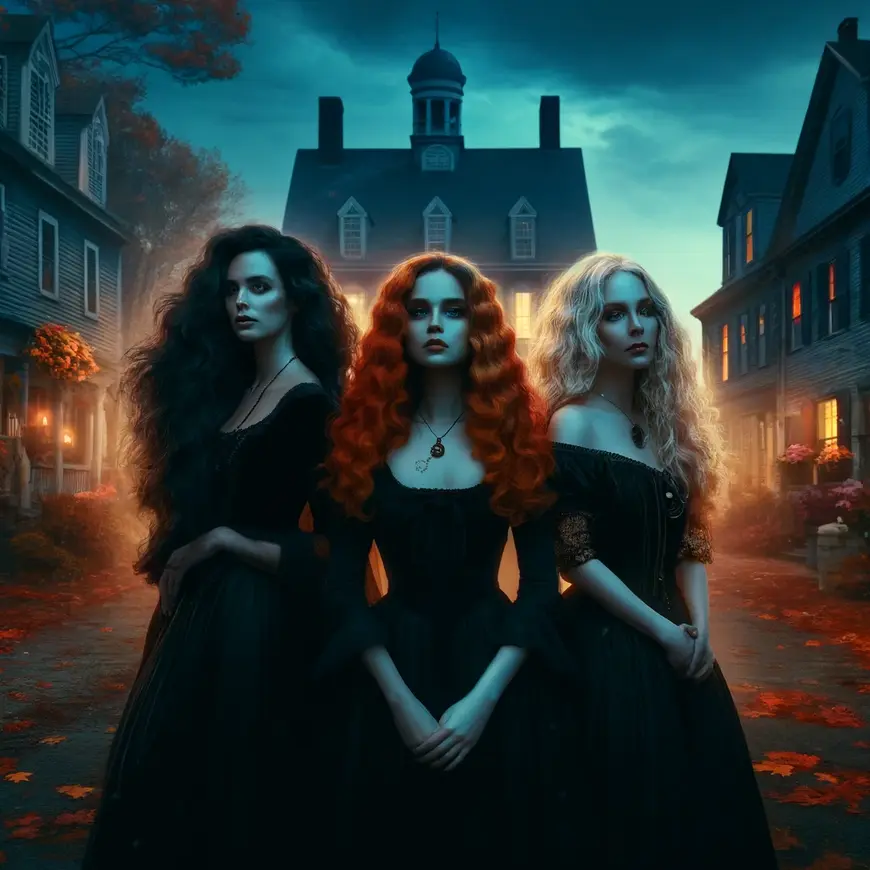“The Witches of Eastwick” by John Updike: A Bewitching Blend of Fantasy and Feminism
John Updike’s “The Witches of Eastwick” is a literary potion that fuses the supernatural with the mundane, creating a heady concoction of magic, desire, and societal critique. In this bewitching tale, Updike takes readers on a journey to the seemingly idyllic town of Eastwick, where three extraordinary women discover their powers and grapple with the complexities of female autonomy.
Conjuring Up Eastwick: Setting the Scene
The novel unfolds in the small, picturesque town of Eastwick, a place that exudes an air of quaint normalcy on the surface. Yet, beneath the veneer of suburban routine lies a mystical undercurrent. The three protagonists, Alexandra, Jane, and Sukie, are not your average small-town residents—they are witches, endowed with supernatural abilities that set them apart from their neighbors.
Updike’s portrayal of Eastwick is a masterstroke in blending the mundane with the magical. The town becomes a microcosm of societal norms and expectations, a canvas upon which the author paints a vivid picture of conformity and rebellion. The juxtaposition of the ordinary and the extraordinary serves as a backdrop for the unfolding drama of the witches’ lives.

Characters: Witches with Depth and Desire
At the heart of “The Witches of Eastwick” are its three charismatic and distinct protagonists. Alexandra, the sculptress; Jane, the music teacher; and Sukie, the journalist, form a triumvirate of women whose powers extend beyond the supernatural. Updike breathes life into these characters, endowing them with flaws, desires, and a complexity that defies stereotypes.
The witches’ relationships with each other, as well as with the enigmatic Darryl Van Horne, a charismatic and somewhat diabolical figure, form the crux of the narrative. Darryl’s arrival in Eastwick acts as a catalyst, disrupting the status quo and awakening the latent powers within the women. The dynamics between the witches and their interactions with Darryl are both intriguing and, at times, unsettling.
Feminism in a Fantastical Veil
Beneath the fantastical elements of magic and witches lies a strong undercurrent of feminist commentary. Updike uses the supernatural powers of his protagonists as a metaphor for female empowerment and autonomy. The witches’ abilities, while fantastical, become a vehicle for exploring societal expectations, gender roles, and the constraints imposed on women in a patriarchal world.
The three women, initially bound by the limitations of their roles in Eastwick, find liberation through their newfound powers. As they explore their magical abilities, they also grapple with questions of identity, desire, and the societal expectations placed upon them. The novel becomes a nuanced exploration of female agency, challenging traditional norms and presenting the witches as complex, multidimensional characters.
Magical Realism: A Delicate Balance
Updike seamlessly weaves elements of magical realism into the fabric of Eastwick, creating a narrative where the supernatural coexists with the everyday. The magic in the novel is not flashy or otherworldly but rather an extension of the characters’ inner selves. Spells are cast over Sunday dinners, and potions are concocted in the midst of mundane domestic activities, grounding the magical elements in the familiar.
The author’s approach to magic is subtle, allowing it to serve as a metaphor for the unseen forces that shape our lives. The witches’ abilities become a lens through which Updike examines the mysteries of human relationships, the consequences of desire, and the boundaries between the known and the unknowable.
Satire and Social Commentary
Beneath the supernatural surface, “The Witches of Eastwick” serves as a satirical commentary on the societal norms and values of 20th-century America. The town of Eastwick becomes a microcosm of middle-class America, with its conservative ideals and judgmental attitudes. Updike uses the witches and Darryl as catalysts for challenging these norms, exposing the hypocrisy and limitations of a society that purports to uphold traditional values.
Darryl Van Horne, a charming and mysterious figure, embodies the disruption of the status quo. His unapologetic hedonism and disregard for societal norms force the residents of Eastwick to confront their own desires and repressed urges. The novel becomes a vehicle for Updike to question the rigidity of societal expectations, especially concerning the roles and behavior of women.
The Dark Side of Desire
As the witches explore their newfound powers and desires, the novel takes a darker turn. The consequences of their actions and the choices they make become a central theme, delving into the complexities of desire and the moral ambiguity that accompanies it. The magic, initially a source of liberation, becomes a double-edged sword, leading the characters into a realm of consequences they hadn’t fully anticipated.
The exploration of desire is not limited to the witches’ relationships with Darryl but extends to their relationships with each other and the townspeople. Updike navigates the intricacies of human desire with a keen eye, revealing the vulnerabilities and dark corners that lie beneath the surface of seemingly normal lives.

Famous Quotes from “The Witches of Eastwick” by John Updike
- “A great deal of talent is lost to the world for the want of a little courage.”
- This quote reflects a central theme of the novel, which is about self-discovery and the courage to embrace one’s own powers and abilities. It suggests that fear and lack of confidence can prevent people from realizing their full potential.
- “The three witches gathered like the fates around the bed, weaving the threads of his destiny.”
- This imagery invokes the mythological Fates, who in Greek mythology control the destinies of humans. The quote symbolizes how the three central characters, Alexandra, Jane, and Sukie, come into their power and begin to influence events around them, especially concerning the male characters in the story.
- “Men are like wax flowing into molds; they take the shape of whatever you cast them in.”
- This quote speaks to the theme of manipulation and control. The women in the novel learn to manipulate the weaker wills of the men around them using their newfound powers. It reflects on the dynamics of power and influence, and perhaps Updike’s view on gender relations.
- “Adultery is the apple of discord, the still center of the destruction of our garden.”
- This quote references the biblical story of the Garden of Eden and the original sin. In the context of the novel, adultery disrupts lives and leads to chaos and change. It serves as a catalyst for many of the novel’s events, reflecting on moral choices and their impacts.
- “Our last freedom is the freedom to choose our own death.”
- This somber quote touches on themes of mortality and autonomy. In “The Witches of Eastwick,” the characters often grapple with the consequences of their freedom, including the most extreme choices about life and death. It can be seen as a comment on the ultimate control we have over our lives.
Trivia Facts about “The Witches of Eastwick”
- Inspired by Real Locations: The setting of Eastwick is inspired by the town of East Greenwich, Rhode Island, near where John Updike lived in the 1960s. Updike used his observations of New England social dynamics as a backdrop for the supernatural events of the novel.
- Controversial Themes: The novel was controversial for its portrayal of witchcraft and feminism. Updike intertwines these elements with themes of moral ambiguity, making it a provocative reflection on the social revolutions of the 1960s and 1970s.
- Critical Reception: While “The Witches of Eastwick” is considered one of Updike’s more popular works, it has received mixed reviews from critics. Some praised its wit and inventiveness, while others criticized it for what they saw as a misogynistic portrayal of its female characters.
- Sequel: John Updike wrote a sequel titled “The Widows of Eastwick,” which was published in 2008, nearly 25 years after the original. The sequel revisits the lives of the three witches, now widowed, as they grapple with the consequences of their earlier actions.
- Adaptations: The novel was adapted into a successful 1987 film starring Jack Nicholson, Cher, Susan Sarandon, and Michelle Pfeiffer. The story was also adapted into a television series in 2002 and a musical.
- Literary Style: Updike is known for his rich prose and detailed descriptions. In “The Witches of Eastwick,” he uses these strengths to explore the inner lives of his characters and the mystical elements of witchcraft in a way that blends the fantastical with the mundane.
- Exploration of Freedom: The novel is often interpreted as an exploration of personal and moral freedom. It delves into the choices the characters make and the repercussions of wielding power, whether supernatural or not.
- Symbolism of the Seasons: Updike uses the changing seasons in New England as a metaphor for the stages of life and the transformations experienced by the main characters. Each witch represents a different aspect of womanhood and power.
Criticisms: A Flawed Masterpiece
While “The Witches of Eastwick” is celebrated for its imaginative narrative and social commentary, it is not without its criticisms. Some readers may find the novel’s treatment of female characters, despite its feminist undertones, as falling into certain stereotypes. The witches, while powerful, are also portrayed as beholden to their desires and susceptible to manipulation by Darryl.
The novel’s resolution, especially concerning Darryl’s fate, has also been a point of contention. Some readers may find the conclusion unsatisfying or ambiguous, leaving questions about the ultimate message Updike intends to convey. Additionally, the blending of fantastical elements with social commentary may not resonate equally with all readers, as some may prefer a more straightforward narrative.
The Legacy of Eastwick: Adaptations and Impact
“The Witches of Eastwick” has left an indelible mark on popular culture, inspiring adaptations in various forms. The novel was adapted into a successful film in 1987, starring Cher, Michelle Pfeiffer, and Susan Sarandon as the witches. The story has also found new life in a television series, cementing its status as a work with enduring appeal.
Beyond its adaptations, the novel’s impact lies in its ability to resonate with readers across generations. The themes of desire, female empowerment, and societal critique remain relevant, ensuring that “The Witches of Eastwick” continues to find new audiences who are captivated by its blend of fantasy and social commentary.
Conclusion: A Spellbinding Exploration of Desire and Empowerment
In the realm of magical realism, “The Witches of Eastwick” stands as a spellbinding exploration of desire, empowerment, and societal norms. John Updike’s ability to infuse the supernatural with the everyday, coupled with his astute social commentary, creates a novel that transcends genres. The witches of Eastwick, with their magical abilities and complex desires, become symbols of resistance against societal constraints, challenging readers to question the status quo.
While not without its flaws, “The Witches of Eastwick” remains a captivating read that invites readers to ponder the intricacies of desire, the consequences of liberation, and the ever-present tension between the magical and the mundane. It is a novel that lingers in the imagination, leaving readers bewitched by its exploration of the fantastical and the all-too-human.